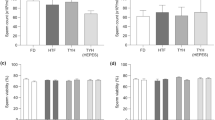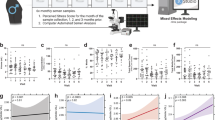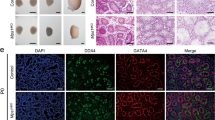Abstract
DURING an investigation of the cytoplasmic inclusions of the fertilized egg of the mouse, the sperm middle-piece, and in some cases the whole tail, was observed in the ooplasm (a and b). The middle-piece usually becomes detached from the sperm-head shortly after the entry of the sperm, but may remain attached until the stage of the pronuclei is reached. The middle-piece is, at first, compact and deeply stained, but soon shows a granular structure. These granules are identified as the mitochondria of the sheath of the axial filament (a, S.M.P.). After the middle-piece is free of the sperm-head the sheath becomes less compact, so that the individual granules can be identified with ease (b, S.M.P.).
This is a preview of subscription content, access via your institution
Access options
Subscribe to this journal
Receive 51 print issues and online access
$199.00 per year
only $3.90 per issue
Buy this article
- Purchase on SpringerLink
- Instant access to full article PDF
Prices may be subject to local taxes which are calculated during checkout
Similar content being viewed by others
References
Lams, H., Arch. Biol., 28 (1913).
Levi, G., Arch. Zellforsch., 13 (1915).
Van der Stricht, O., Arch. Biol., 33 (1923).
Held, H., Arch. Mikr. Anat., 89 (1917).
Author information
Authors and Affiliations
Rights and permissions
About this article
Cite this article
GRESSON, R. Presence of the Sperm Middle-Piece in the Fertilized Egg of the Mouse (Mus musculus). Nature 145, 425 (1940). https://doi.org/10.1038/145425b0
Issue date:
DOI: https://doi.org/10.1038/145425b0
This article is cited by
-
Complete moles have paternal chromosomes but maternal mitochondrial DNA
Human Genetics (1982)
-
Mitotic segregation of cytoplasmic determinants for chloramphenicol resistance in mammalian cells II: Fusions with human cell lines
Somatic Cell Genetics (1977)
-
Maternal inheritance of mammalian mitochondrial DNA
Nature (1974)



